Graph Coloring Problems Examples
Vertex coloring Greedy Algorithm Example
Use the Welsh-Powell greedy algorithm and find the coloration for the following graph. Is it the optimal solution?
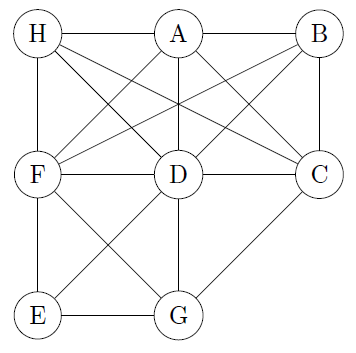
- $d(D)=7$
- $d(F)=6$
- $d(A)=d(C)=5$
- $d(B)=d(G)=d(H)=4$
- $d(E)=3$
Giving us the following table:
| Colors\Vertex | D | F | A | C | B | G | H | E |
|---|---|---|---|---|---|---|---|---|
| Red | o | x | x | x | x | x | x | x |
| Yellow | o | x | o | x | x | x | x | |
| Green | o | x | x | o | x | |||
| Blue | o | o | o |
- o=colored
- x=not colored since neighbor to a colored
- "nothing"=already colored
The longest clique is $D-C-A-H$ (size=4) and we colored the graph in $4$ colors, so this is the optimal solution. We had the clique $F-D-G-E$ too.
Vertex coloring Contraction Algorithm Example
Use the contraction algorithm to find a coloration for this graph:
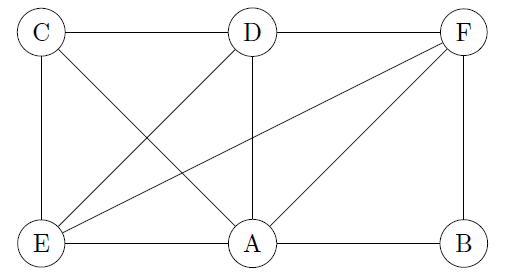
We have 4 missing edges, so we will have up to $2^4=16$ subgraphs. We are missing the following edges: $[c,b], [d,b], [e,b], [c,f]$.
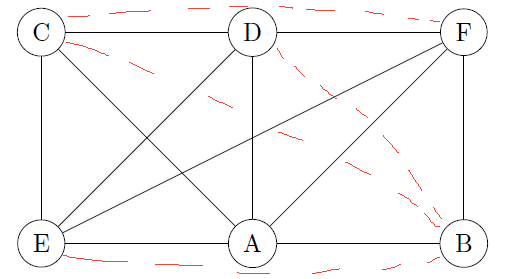
Let's apply the algorithm (note: C=Contraction, L=Link=Connect):
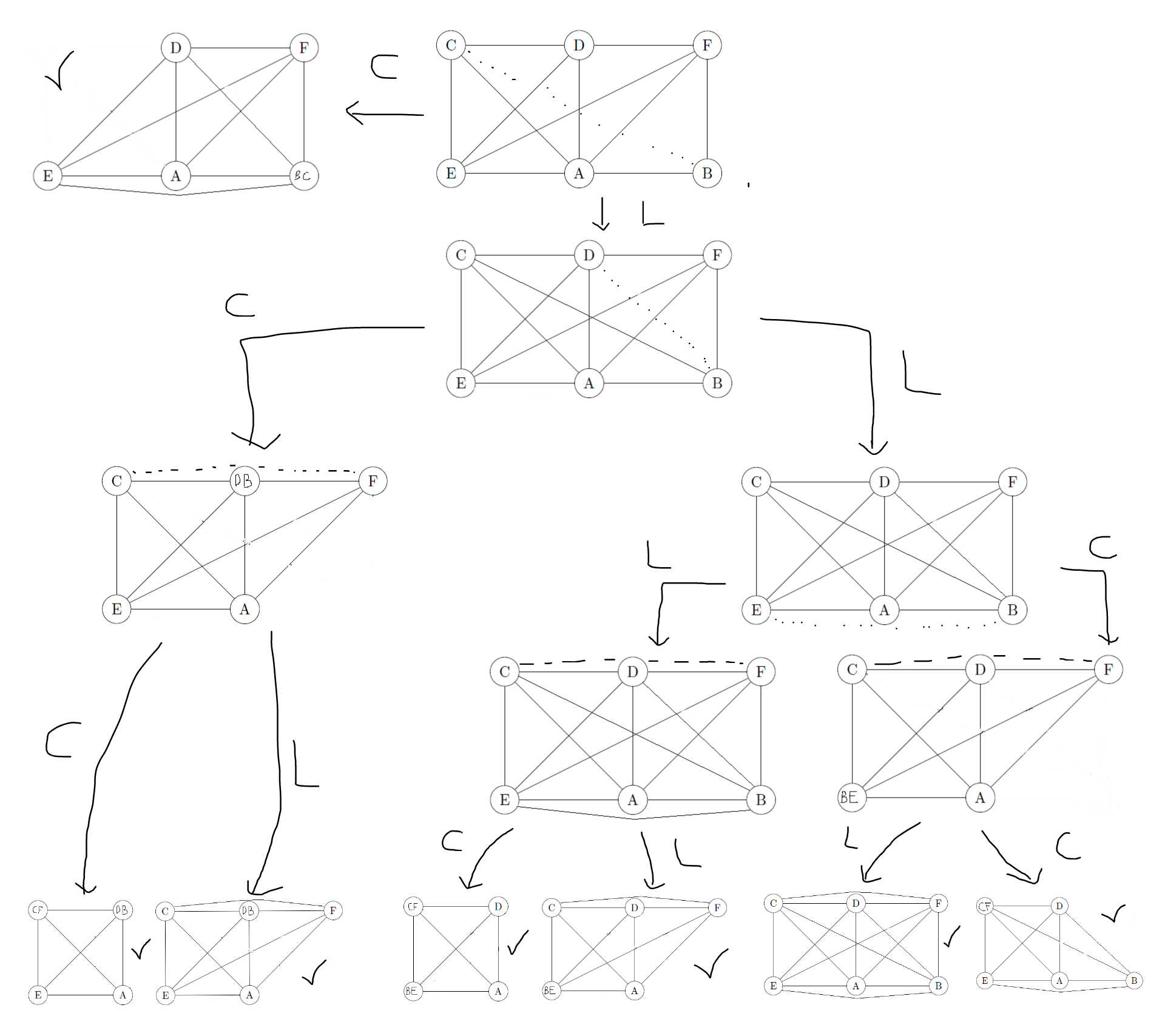
The smallest clique among the 7 graphs with the symbol ✔️ is:
- $CF-DB-E-A$: 4 colors
- $CF-D-BE-A$: 4 colors
It means one way to color the graph is:
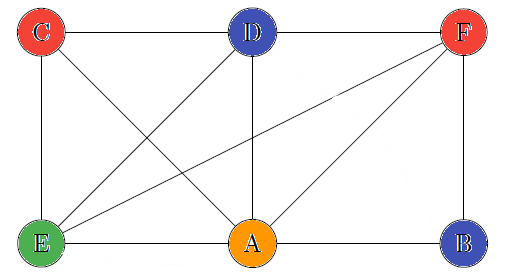
Grundy Function Example 1
Use Grundy on the following graph $G$:

Using Grundy function, starting from $1$, we have:

- The first one is in the kernel, so $g(1)=0$
- Next is the successor $2$
- the neighbors took the values $\text{{0}}$
- the lowest value we can give is $1$
- $g(2)=1$
- Next are the successors $3,5$
- ... $\text{{1}}$, the lowest ... $0$
- $g(3)=0$ and $g(5)=0$
- Next is the successor $4$
- ... $\text{{0}}$, the lowest ... $1$
- $g(4)=1$
- Next is the successor $6$
- ... $\text{{0}}$, the lowest ... $1$
- $g(6)=1$
We got the kernel $(1,5,3)$. Starting from another vertex like $4$, we would have found the other kernel $(2,4,6)$.
Grundy Function Example 2
Find a kernel for this graph using the grundy function
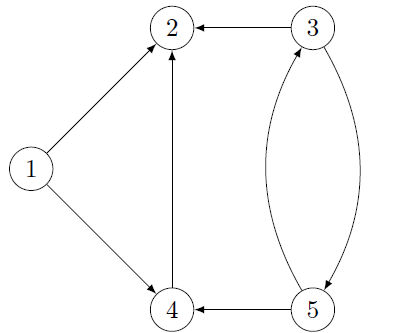
Vertex $1$ does not have any predecessors, so we must start at $1$.

Then:
- $g(2)=g(4)=1$ because $g(1)=0$
- $g(2)=2$ because we have the predecessors already have:
- $g(1)=0$
- $g(4)=1$
- Then we have a choice (=two kernels)
- $g(5)=0$ and $g(3)=1$
- $g(3)=0$ and $g(5)=2$
Grundy Function Example 3
Find a kernel for this graph using the Grundy function after sorting the vertices by successors.
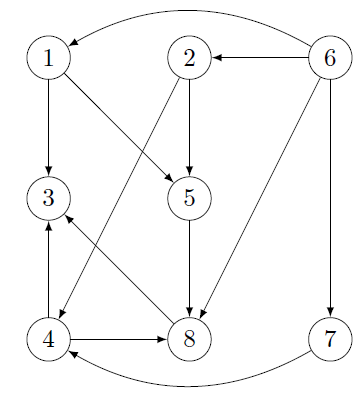
Let's sort the vertices:
- $3$: 0 successor
- $5$: 1 successor
- $7$: 1 successor
- $8$: 1 successor
- $1$: 2 successors
- $2$: 2 successors
- $4$: 2 successors
- $6$: 4 successors
And the result is:

- $g(3)=0$ (no successors $\to$ should be the start, inside the kernel)
- $5$ is not a neighbor of $3$: $g(5)=0$
- $7$ is not a neighbor of $3,5$: $g(7)=0$
- $8$ is a neighbor of $g(3)=0$: $g(8)=1$
- $1$ is a neighbor of $g(3)=0, g(5)=0$: $g(1)=1$
- $4$ is a neighbor of $g(3)=0, g(8)=1$: $g(4)=2$
- $2$ is a neighbor of $g(5)=0, g(4)=2$: $g(2)=1$
- $6$ is a neighbor of $g(1)=g(2)=g(8)=1, g(7)=0$: $g(6)=2$
The kernel is $3,5,7$.
Grundy Function Example 4
Given this adjacency matrix, calculate the Grundy function.
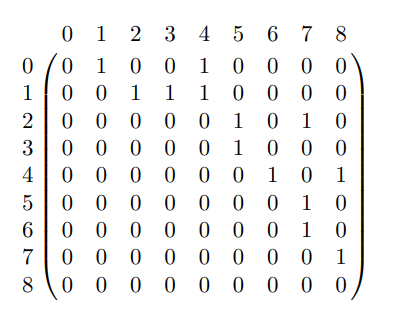
Let's sort the vertices
- $0$: 2 successor
- $1$: 3 successor
- $2$: 2 successor
- $3$: 1 successor
- $4$: 2 successor
- $5$: 1 successor
- $6$: 1 successor
- $7$: 1 successor
- $8$: 0 successor
Giving us $8-3-5-6-7-0-2-4-1$.
- $g(8)=0$ (no successors $\to$ should be the start, inside the kernel)
- $7$ is a neighbor of $g(8)=0$: $g(7)=1$
- $5$ is a neighbor of $g(7)=1$: $g(5)=0$
- $3$ is a neighbor of $g(5)=0$: $g(3)=1$
- $6$ is a neighbor of $g(7)=1$: $g(6)=0$
- $4$ is a neighbor of $g(8)=g(6)=0$: $g(4)=1$
- $2$ is a neighbor of $g(7)=1, g(5)=0$: $g(2)=2$
- $1$ is a neighbor of $g(2)=2, g(3)=g(4)=1$: $g(1)=0$
- $0$ is a neighbor of $g(1)=0, g(4)=1$: $g(0)=2$
The kernel is $1,5,6,8$.
Note: we processed $7$ before $3$/$5$ because both depended on it.

